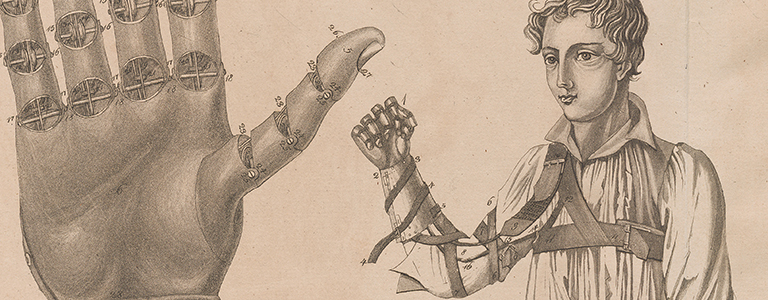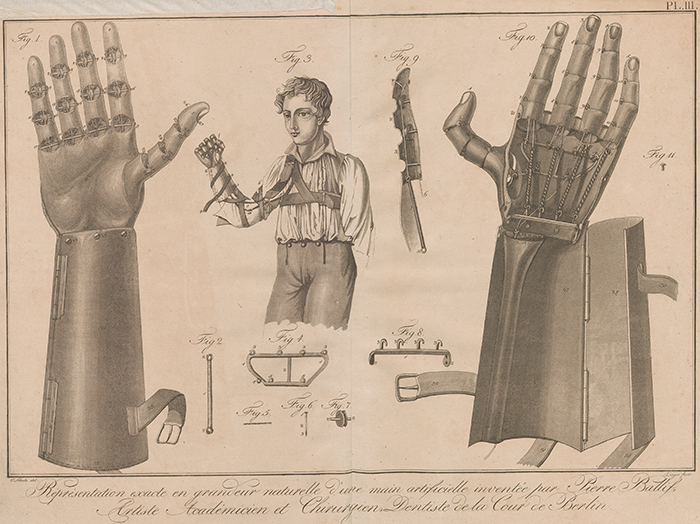When demand for prostheses increased massively in war-torn Europe at the beginning of the nineteenth century, Pierre Ballif (1775–1831), personal dentist to the King of Prussia in Berlin, developed new technology and in doing so created the basis for the further development of artificial limbs.
The hand prostheses existing at that time after the Coalition Wars had a major drawback in that they could only be operated using the other, healthy hand. The prostheses of the knight Götz von Berlichingen on display in the Götzenburg castle museum are famous. The older model consists of two movable blocks of fingers and a thumb. The newer, much more complex and more celebrated hand prosthesis enables all three joints of the fingers to be moved. In mechanical terms, it is a construction consisting of springs and gut strings. Catches are responsible for locking the moving parts. The hand’s original position could be restored at the push of a button.
Based on these prostheses, Ballif was the first, in 1812, to construct an artificial hand that could be used alone through the muscles of the disabled arm:
‘La main est susceptible de se mouvoir à volonté, sans le secours de l’autre main; elle peut prendre un verre sur la table, le porter à la bouche et le reposer sur la table sans éffort, avec la même facilité que peut le faire une main naturelle […].’ Préface [p. 11]
Ballif’s innovation is a complex system of springs and drawstrings connected above the upper arm and shoulder with a chest strap. The hand could be controlled by stretching the arm (see Pl. III, Fig. 3).
Réprésentation exacte en grandeur naturelle d’une main artificielle (…), Pl. III
Even though Ballif’s construction represented significant progress and formed the basis for the further development of prostheses, it was not without its critics. Hermann Eduard Fritze found fault with the seemingly unnatural closed fist in the passive state, resulting in a threatening aspect, and particularly the lesser gripping force compared with a system in which muscular strength could be used for closing the fingers.
It was in 1836 that the Berlin instrument maker Margarethe Karoline Eichler refined Ballif’s technique in this direction. Stretching the arms led to a closed fist and thus a more effective prosthesis. But Ballif created the first prosthesis that could be moved just with the muscles of the amputated arm and wrote history with this iron hand. Anyone also interested in studying Ballif’s leg prosthesis is cordially invited to view the work online at e-rara.ch.
Literature:
Ballif, Pierre: Description d’une main et d’une jambe artificielles. Berlin: [s.n.], 1818, http://dx.doi.org/10.3931/e-rara-56382
Karpa, Martin Friedrich: Die Geschichte der Armprothese unter besonderer Berücksichtigung der Leistung von Ferdinand Sauerbruch (1875-1951). Dissertation, Ruhr-Universität Bochum, 2004, pp. 21-23
Fritze, Hermnn Eduard: Arthroplastik, oder, die sämmtlichen, bisher bekannt gewordenen künstlichen Hände und Füsse, Ersatz dieser verloren gegangenen Gliedmassen (…). Lemgo, Verlag der Meyer’schen Hof-Buchhandlung, 1842, pp. 24-27

